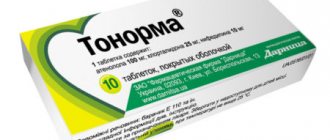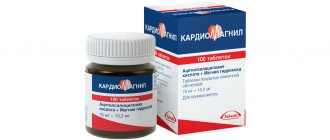Captopril Sandoz®
Arterial hypotension
In patients with arterial hypertension, when using captopril, severe arterial hypotension is observed only in rare cases. The likelihood of developing this condition increases with increased fluid loss and hyponatremia (for example, after intensive treatment with diuretics, restriction of sodium intake, in patients on dialysis, and in patients with diarrhea or vomiting).
Captopril should be prescribed with caution to patients on a low-salt or salt-free diet. Circulating blood volume and blood sodium levels should be adjusted before captopril is prescribed. The possibility of a sharp decrease in blood pressure can be minimized by first withdrawing (4-7 days before) the diuretic or increasing sodium chloride intake (about a week before starting treatment), or by prescribing low doses of captopril at the beginning of treatment (6.25-12 .5 mg/day). Renal function should be regularly monitored before and during treatment with captopril.
Excessive reduction in blood pressure due to antihypertensive medications may increase the risk of myocardial infarction or stroke in patients with coronary heart disease or cerebrovascular disease. If arterial hypotension develops, the patient should take a horizontal position with legs elevated. Intravenous administration of 0.9% sodium chloride solution may be required.
In patients with CHF, a transient decrease in blood pressure by more than 20% of the initial value is observed in approximately half of the cases. The degree of reduction in blood pressure is maximum in the early stages of treatment (after taking the first few doses of captopril) and stabilizes within one to two weeks from the start of treatment. Blood pressure usually returns to baseline without a decrease in therapeutic efficacy within two months. In patients with CHF, treatment should begin with low doses of captopril (6.25-12.5 mg/day) under medical supervision. Increasing the dose of captopril should be carried out with extreme caution. Transient arterial hypotension in itself is not a reason to discontinue treatment. In cases where arterial hypotension becomes stable, the dose should be reduced and/or discontinued use of the diuretic and/or captopril.
Aortic or mitral stenosis/hypertrophic obstructive cardiomyopathy
Like all drugs that have a vasodilating effect, ACE inhibitors should be used with extreme caution in patients with left ventricular outflow tract obstruction. In case of hemodynamically significant obstruction, the use of captopril is not recommended.
Renal dysfunction
Some patients with kidney disease, especially those with severe renal artery stenosis, experience increases in serum urea nitrogen and creatinine concentrations after lowering blood pressure. This increase is usually reversible when captopril therapy is discontinued. In these cases, it may be necessary to reduce the dose of captopril and/or discontinue the diuretic. With long-term use of captopril, approximately 20% of patients experience an increase in serum urea and creatinine concentrations by more than 20% compared with normal or baseline values.
In less than 5% of patients, especially with severe nephropathy, treatment discontinuation is required due to an increase in creatinine concentration.
Renovascular hypertension
Patients with bilateral renal artery stenosis or stenosis of the artery of a solitary kidney have an increased risk of developing arterial hypotension and renal failure when using ACE inhibitors. Renal failure may initially manifest itself as only slight changes in plasma creatinine levels. The use of captopril in such patients is not recommended.
Kidney transplant
There is no experience with the use of captopril in patients who have recently undergone kidney transplantation. Therefore, the use of captopril in such patients is not recommended.
Proteinuria
When using captopril, 0.7% of patients had proteinuria more than 1000 mg per day. In 90% of cases, proteinuria occurred in patients with impaired renal function, as well as when using high doses of captopril (more than 150 mg per day). Approximately 20% of patients with proteinuria developed nephrotic syndrome. In most cases, proteinuria disappeared or decreased in severity after taking captopril within 6 months, regardless of whether the drug was stopped or not. Renal function tests (blood urea nitrogen and creatinine concentrations) in patients with proteinuria were almost always within normal limits. In patients with kidney disease, the protein content in the urine should be determined before starting treatment and periodically throughout the course of therapy.
Liver dysfunction
In rare cases, the use of ACE inhibitors has been accompanied by the development of a syndrome that begins with the appearance of cholestatic jaundice or hepatitis and progresses to fulminant liver necrosis, sometimes with death. The mechanism of development of this syndrome is unknown. If a patient receiving ACE inhibitor therapy develops jaundice or a significant increase in liver enzyme activity, captopril treatment should be discontinued and appropriate adjuvant therapy should be instituted. The patient should be under appropriate supervision.
Neutropenia/agranulocytosis/thrombocytopenia/anemia
Cases of neutropenia/agranulocytosis, thrombocytopenia and anemia have been reported in patients taking ACE inhibitors. In patients with normal renal function and in the absence of other disorders, neutropenia is rare. In renal failure, simultaneous administration of captopril and allopurinol led to neutropenia.
Captopril should be used with extreme caution in patients with systemic connective tissue diseases (systemic lupus erythematosus, scleroderma, etc.) taking immunosuppressants, allopurinol or procainamide, or a combination of these complicating factors, especially if there are pre-existing renal dysfunction.
In 13% of cases with neutropenia, death was observed. In almost all cases, death was observed in patients with connective tissue diseases, renal or heart failure, while taking immunosuppressants, or a combination of both of these factors.
Due to the fact that the majority of fatal cases of neutropenia due to ACE inhibitors developed in such patients, their white blood cell count should be monitored before starting treatment, in the first 3 months - every 2 weeks, then every 2 months. In all patients, the white blood cell count should be monitored monthly for the first 3 months after starting captopril therapy, then every 2 months. If the number of leukocytes is below 4000/μl, a repeat general blood test is indicated; below 1000/μl, the drug is stopped while monitoring the patient continues. Typically, restoration of the number of neutrophils occurs within 2 weeks after discontinuation of captopril.
Some patients developed serious infectious diseases, which in some cases did not respond to intensive antibiotic therapy. When using captopril in patients with a high risk of neutropenia/agranulocytosis, regular monitoring of the number of leukocytes in the blood is recommended. Patients should be warned to seek immediate medical attention if any signs of an infectious disease (eg, fever, sore throat) occur.
Hypersensitivity reactions/angioedema
Rare cases of angioedema of the face, extremities, lips, tongue, vocal folds and/or larynx have been observed with the use of ACE inhibitors, including captopril. Angioedema may develop at any time during treatment.
If angioedema develops, you should immediately stop taking captopril and carefully monitor the patient's condition until symptoms disappear completely.
If the swelling is localized to the face, no special treatment is usually required (antihistamines can be used to reduce the severity of symptoms). Even in cases where only swelling of the tongue is observed without the development of respiratory distress syndrome, patients may require long-term observation, since therapy with antihistamines and corticosteroids may not be sufficient.
Angioedema, associated with swelling of the larynx and tongue, can be fatal in very rare cases. If the swelling spreads to the tongue, pharynx or larynx and there is a threat of developing airway obstruction, 0.3-0.5 ml of a 0.1% solution of epinephrine (adrenaline) should be immediately administered subcutaneously and/or ensure airway patency ( intubation or tracheostomy).
In rare cases, during therapy with ACE inhibitors, intestinal edema (angioedema of the intestines) developed, which was manifested by abdominal pain in combination with nausea and vomiting or without them), sometimes without previous angioedema of the face and with normal levels of C1-esterase. Diagnosis is made using abdominal computed tomography, ultrasound, or surgery.
Symptoms disappeared after stopping the ACE inhibitors. The possibility of developing intestinal edema must be taken into account when carrying out the differential diagnosis of abdominal pain in patients taking ACE inhibitors.
Patients with a history of angioedema not associated with ACE inhibitors may be at greater risk of developing angioedema during ACE inhibitor therapy.
In representatives of the Negroid race, cases of the development of angioedema when using ACE inhibitors were observed with a higher frequency compared to representatives of other races.
An increased risk of developing angioedema was observed in patients concomitantly taking ACE inhibitors and drugs such as mTOR inhibitors (temsirolimus, sirolimus, everolimus), dipeptidyl peptidase type IV inhibitors (sitagliptin, saxagliptinvildagliptin, linagliptin), estramustine, neutral endopeptidase inhibitors (racecadotril, sacubitril). ) and tissue plasminogen activators.
Anaphylactoid reactions during desensitization with an allergen from Hymenoptera venom
In rare cases, during therapy with ACE inhibitors, life-threatening anaphylactoid reactions were observed in patients undergoing desensitization with an allergen from the venom of Hymenoptera. In such patients, these reactions were prevented by temporarily stopping ACE inhibitor therapy before desensitization began. The use of captopril should be avoided in patients receiving bee venom immunotherapy.
Anaphylactoid reactions during low-density lipoprotein apheresis (LDL apheresis)
Life-threatening anaphylactoid reactions have rarely been observed in patients taking ACE inhibitors during LDL apheresis using dextran sulfate. The development of these reactions can be prevented by temporarily discontinuing the ACE inhibitor before each LDL apheresis procedure.
Hemodialysis using high-flow membranes
When performing hemodialysis in patients receiving ACE inhibitors, the use of high-flow polyacrylonitrile dialysis membranes (for example, AN69®) should be avoided, since in such cases the risk of developing anaphylactoid reactions increases. In such cases, it is necessary to use a different type of dialysis membrane or use antihypertensive drugs of other classes.
Diabetes
In patients with diabetes mellitus receiving oral hypoglycemic agents or insulin while using ACE inhibitors, blood glucose concentrations should be regularly monitored. Patients taking oral hypoglycemic agents or insulin should be informed before starting the use of ACE inhibitors of the need to regularly monitor blood glucose concentrations (hypoglycemia), especially during the first month of simultaneous use of these drugs.
Cough
When taking ACE inhibitors, a characteristic cough is often observed. As a rule, the cough is non-productive, constant and stops after discontinuation of the drug. Cough associated with the use of ACE inhibitors should be considered in the differential diagnosis of dry cough.
Surgery/general anesthesia
During major surgical operations, as well as when using general anesthesia agents that have an antihypertensive effect, patients taking ACE inhibitors may experience an excessive decrease in blood pressure (since captopril blocks the formation of angiotensin II, caused by compensatory release of renin). In such cases, to correct low blood pressure, measures aimed at increasing the volume of circulating blood are used.
Hyperkalemia
In some cases, against the background of the use of ACE inhibitors, incl. captopril, an increase in serum potassium levels is observed. Risk factors for the development of hyperkalemia are renal failure, old age (over 65 years), diabetes mellitus, some concomitant conditions (decrease in blood volume, acute heart failure in the stage of decompensation, metabolic acidosis), simultaneous use of potassium-sparing diuretics (such as spironolactone, eplerenone, triamterene or amiloride), as well as potassium preparations, potassium-containing table salt substitutes and other drugs that help increase potassium levels in the blood plasma (such as heparin, tacrolimus, cyclosporine; drugs containing co-trimoxazole [trimethoprim + sulfamethoxazole]. The use of potassium supplements, potassium-sparing diuretics or potassium-containing substitutes for table salt, especially in patients with impaired renal function, can lead to a significant increase in serum potassium levels.Hyperkalemia can lead to serious cardiac arrhythmias, sometimes fatal.
It is recommended to avoid the simultaneous use of potassium-sparing diuretics and potassium supplements. If simultaneous use of captopril and the above-listed potassium-containing or potassium-increasing drugs in the blood plasma is necessary, caution should be exercised and the potassium content in the blood serum should be regularly monitored.
Hypokalemia
When using ACE inhibitors simultaneously with thiazide diuretics, the risk of hypokalemia cannot be excluded. Therefore, in such cases, regular monitoring of potassium levels in the blood should be carried out during therapy.
Dual blockade of the renin-angiotensin-aldosterone system (RAAS)
The simultaneous use of drugs from different groups that act on the RAAS is not recommended (double blockade of the RAAS), since it has been associated with an increased incidence of side effects such as arterial hypotension, hyperkalemia, and decreased renal function (including acute renal failure).
The simultaneous use of ACE inhibitors with medicinal products containing aliskiren is contraindicated in patients with diabetes mellitus and/or with moderate or severe renal impairment (GFR less than 60 ml/min/1.73 m2 body surface area) and is not recommended in other patients. Concomitant use of ACE inhibitors with angiotensin II receptor antagonists is contraindicated in patients with diabetic nephropathy and is not recommended in other patients.
In cases where the simultaneous administration of two drugs acting on the RAAS is necessary, their use should be carried out under the supervision of a physician with extreme caution and with regular monitoring of renal function, blood pressure and electrolyte levels in the blood plasma.
Lithium preparations
The simultaneous use of captopril and drugs containing lithium is not recommended due to the risk of potentiating the toxicity of the latter.
Ethnic differences
ACE inhibitors are less effective in blacks than in Caucasians, which may be due to the higher prevalence of low renin activity in blacks.
Other
When taking captopril, a false-positive urine test for acetone may occur.
Captopril Sandoz
Before starting, as well as during treatment with the drug, blood pressure and kidney function should be regularly monitored. In patients with chronic heart failure, the drug is used under close medical supervision.
Arterial hypotension
In patients with arterial hypertension, when using the drug, severe arterial hypotension is observed only in rare cases; the likelihood of developing this condition increases with a decrease in circulating blood volume and an imbalance in water and electrolyte balance (for example, after treatment with high doses of diuretics), in patients with chronic heart failure or on hemodialysis. The possibility of a sharp decrease in blood pressure can be minimized by prior withdrawal (4-7 days) of the diuretic or replenishment of circulating blood volume (about a week before use), or by using the drug in small doses (6.25-12.5 mg /day) at the beginning of treatment.
When using antihypertensive drugs, a pronounced decrease in blood pressure in patients with cerebrovascular accidents and cardiovascular diseases may increase the risk of myocardial infarction or stroke. If arterial hypotension has developed, the patient should be placed in a supine position with legs elevated. Sometimes it may be necessary to replenish the volume of circulating blood.
Renovascular hypertension
There is an increased risk of hypotension and renal failure in patients with bilateral renal artery stenosis or solitary renal artery stenosis when using ACE inhibitors.
Impaired renal function can occur with moderate changes in serum creatinine concentrations. In such patients, therapy should be initiated under close medical supervision with low doses, carefully titrated and with monitoring of renal function. The use of ACE inhibitors, including the drug, with aliskiren should be avoided in patients with severe renal impairment (GFR less than 60 ml/min/1.73 m).
Proteinuria
In patients, especially with impaired renal function or in combination with relatively high doses of ACE inhibitors, taking the drug, proteinuria may occur. In most cases, proteinuria decreased or disappeared within 6 weeks, regardless of whether treatment with the drug was continued or not. Renal function parameters such as residual blood nitrogen and creatinine rarely changed in patients with proteinuria.
Hyperkalemia
In some cases, when using the drug, an increase in potassium levels in the blood serum is observed. The risk of developing hyperkalemia when using ACE inhibitors is increased in patients with renal failure and diabetes mellitus, as well as those taking potassium-sparing diuretics, potassium supplements and other drugs that cause an increase in potassium levels in the blood (for example, heparin). The simultaneous use of potassium-sparing diuretics and potassium supplements should be avoided. Use with caution in patients on a low-salt or salt-free diet (increased risk of developing arterial hypotension) and hyperkalemia.
Neutropenia/agranulocytosis
In the first 3 months of therapy, the number of leukocytes in the blood is monitored monthly, then once every 3 months. Neutropenia/agranulocytosis, anemia and thrombocytopenia have been reported in patients taking ACE inhibitors, including the drug. In patients with normal renal function and no other complicating factors, neutropenia rarely occurs. The drug should be used with great caution in patients with connective tissue diseases and simultaneously receiving immunosuppressive therapy (allopurinol or procainamide), especially with existing renal impairment. In such patients, a clinical blood test is monitored every 2 weeks in the first 3 months, then every 2 months. If the number of leukocytes is below 4000/μl, a general blood test is indicated once a week; below 1000/μl, the use of the drug is stopped. These patients may develop severe infections that do not respond to intensive antibiotic therapy. During treatment, all patients should be instructed that if signs of infection occur (eg, sore throat, fever), they should notify their physician and have a complete blood count with a white blood cell count performed. In most patients, the white blood cell count quickly returns to normal when treatment with the drug is stopped.
Anaphylactoid reactions
In patients taking the drug during desensitizing therapy with hymenoptera venom, etc., the risk of developing anaphylactoid reactions is increased. This can be avoided if you first temporarily stop taking the drug.
When performing hemodialysis in patients receiving the drug, the use of high permeability dialysis membranes (for example, AN69R) should be avoided, as in such cases the risk of developing anaphylactoid reactions increases.
In rare cases, life-threatening anaphylactoid reactions may occur in patients receiving ACE inhibitors during low-density lipoprotein (LDL) apheresis using dextran sulfate. To prevent anaphylactoid reactions, ACE inhibitor therapy should be discontinued before each LPNHT apheresis procedure using high-flux membranes.
Angioedema
In patients taking the drug, when abdominal pain occurs, it is necessary to differentiate it from intestinal angioedema.
If angioedema develops, the drug is discontinued and careful medical supervision is provided. If the swelling is localized on the face, special treatment is usually not required (antihistamines can be used to reduce the severity of symptoms); in the event that the swelling spreads to the tongue, pharynx or larynx and there is a threat of developing airway obstruction and a threat to the patient’s life, epinephrine (adrenaline) should be immediately administered subcutaneously (0.5 ml in a dilution of 1:1000), and also make sure that airway patency. It is recommended to stop taking ACE inhibitors, including the drug, 12 hours before surgery, warning the surgeon-anesthesiologist about the use of ACE inhibitors.
Cough
The development of a non-productive, prolonged cough when using ACE inhibitors is reversible and resolves after discontinuation of treatment.
Diabetes
In patients with diabetes mellitus taking oral hypoglycemic agents or insulin, blood glucose concentrations should be regularly monitored during the first month of treatment with the drug.
Liver dysfunction
During therapy with ACE inhibitors, several cases of liver dysfunction with cholestatic jaundice, fulminant liver necrosis (in some cases) with a fatal outcome have been reported.
If jaundice develops during drug therapy or the activity of “liver” transaminases increases, the drug should be discontinued immediately; the patient should be closely monitored and, if necessary, receive appropriate therapy.
Hypokalemia
The simultaneous use of an ACE inhibitor and a thiazide diuretic does not exclude the possibility of hypokalemia. It is recommended to regularly monitor potassium levels in the blood.
Surgery/anesthesia
Hypotension may occur in patients undergoing major surgery or during the use of anesthetics known to lower blood pressure. If arterial hypotension occurs, it is recommended to replenish the circulating blood volume.
Ethnic differences
ACE inhibitors, including captopril, have a less pronounced antihypertensive effect in black patients, which is apparently due to the frequent occurrence of low renin activity in this group of patients.
Laboratory data
The drug may cause a false-positive urine test for acetone.
Impact on the ability to drive vehicles and operate machinery
During the treatment period, it is necessary to refrain from driving vehicles and engaging in potentially hazardous activities that require increased concentration and speed of psychomotor reactions, because Dizziness may occur, especially after taking the initial dose.








